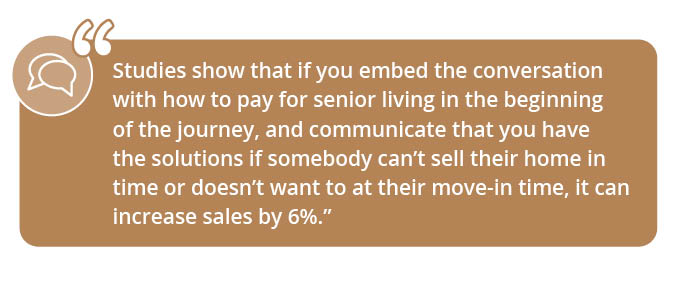In case you couldn’t make it to our December Sales & Marketing Roundtables, here are some of the trends we saw in senior living last month, and a look forward to 2023.
- Holiday Conversations. New Year’s Conversions.
Many participants saw sales activity gaining momentum in December. At this time of year, children come home for the holidays and notice that Mom and Dad aren’t getting around as well as they used to, and might benefit from senior living options. Sales and marketing leaders saw leads pick up, which will hopefully become conversions in January now that the busy holiday season is over.
- Connecting With Kinless Seniors
A frequent topic of conversation in December was “kinless” seniors, or seniors who do not have family support, whether it be because they never married, never had kids, are widowed, or for whatever reason don’t have a support network nearby. Kinless seniors can be uniquely limited in their caregiving support, and senior living communities can be well equipped to serve them.
“There are quite a few kinless folks who visit us. And I see them as very proactive, coming in and talking to us about their future plans, making sure they have their legal documents in order.” (Washington state)
- Nearly Universal Rate Increases — and Tips for Communicating Them
Entry fees and monthly service fees are being raised for 2023 in most senior living communities.
“The industry standard is a 9% to 10% increase, on average this year. (Pennsylvania)
Sales and marketing leaders shared helpful tips on how to best communicate rate increases with residents. It was agreed that it’s best to be extremely transparent with why fees have to go up, and to go into detail about why.
“We were extremely clear about why we raised rates and broke down the pricing for our residents. We were clear on what we spent on renovation and really broke it down. We also showed figures of how the minimum wage is going up, how utilities have increased, how the food bills have gone up.” (Massachusetts)
When using this up-front approach, residents tend to have less pushback and are more accepting of the current situation.
- Loneliness as a Public Health Problem
Americans are spending more and more hours alone than ever before. Our time spent alone has increased by over nine hours a week. This trend started well before the pandemic, although 2020 surely exacerbated it, and we know that time spent alone dramatically increases as we age. We discussed that it could be valuable for sales teams to convey that time spent alone can be dramatically reduced for people who live in senior communities.
- Competition Changing to At-Home Options
Sales and marketing leaders agree that their competition isn’t necessarily the other community down the road — especially for independent living. More often, they’re competing against home health agencies and private duty care.
“I have always said that I feel like other communities aren’t our competitors. We’re all competing against the home and the prospect staying at home.” (Washington state)
“It’s when the home is no longer working for them that people start calling us.” (Massachusetts)
See what’s new in senior living for 2023 at our weekly Sales & Marketing Roundtables. Join us on Thursdays at noon ET, 11 a.m. CT and 9 a.m. PT.
For login information, email














